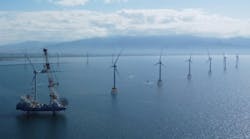Dick Hill
ARC Advisory Group
While it might be human nature to feel that the professional challenges each of us face every day are unique, when it comes to automation and asset lifecycle management, many common challenges span across both different companies and even widely different industries.
While business and production objectives may vary greatly from company to company and from industrial sector to industrial sector; nearly everyone needs to move projects from plan to startup as quickly as possible, using as few resources (and as little capital) as possible, and without missteps that require rework or cause delays. And all industrial companies must manage their production assets and associated automation assets effectively over the entire asset lifecycle.
As readers ofOffshore magazine already know all too well, this is particularly problematic in the asset-intensive upstream oil and gas industry, as many of those assets are now being located in increasingly remote, hostile, and/or deepwater locations around the globe.
One session at the recent ARC Advisory Group Industry Forum in Orlando, Florida, focused on the automation side of this equation. Here, senior automation specialists from the oil and gas and other industries shared their challenges (along with some recommended solutions for automation suppliers and users), with the session participants. While the production processes were very different, the automation-related challenges were amazingly similar.
New approaches needed
Automation technology suppliers have come a long way over the last several decades. But technology alone is not sufficient to address the multiple challenges that today's industrial organizations face. These challenges span both the project design/construction/commissioning phase for a new industrial facility (such as a fixed or floating offshore production platform or subsea production equipment); and the much longer operations and maintenance phase, in which ongoing improvements over the lifecycle of the facilities can play such a critical part in the businesses' success. For many upstream oil and gas and other industrial assets, this lifecycle can span decades. And, while it may just represent a small fraction of the overall project cost, automation plays a key role in operations and maintenance.
During the capital project phase of an oil or gas production asset (whether fixed, floating, subsea, or whatever), the challenge for the automation team is often simply to keep their needs off the critical path; without compromising the end results at startup and commissioning.
During the much longer (5-, 10-, 15-, 20-years or more) operations and maintenance phase of the industrial asset's lifecycle, the automation team must be able to modify, update, and improve the automation assets on almost a continuous basis; and do so at minimum cost, with minimum production interruptions, and often, with shrinking internal resources.
As we learned during the well-attended "Automation Challenge" session at the forum, this requires technology users and suppliers alike to apply whole new approaches.
In his forum presentation, Sandy Vasser, Facilities I&E Manager, ExxonMobil Development Co., used the phrase "it just happens" to indicate his team's goal for the automation portion in each of the more than 100 oil and gas projects now in various stages of planning and execution at ExxonMobil.
This is meant to convey the fact that it is too costly and too difficult to manage complex automation projects using the same approaches as in the past. Vasser called upon both his own resources and those of his technology suppliers to "step way back and look at whole new ways of doing things." He noted that "by default, projects are sequential in nature…and things are never ready at factory acceptance testing." He believes the industry needs to adopt "lean project execution," an approach which separates the physical system from the software. Toward this end, the technology suppliers have to think differently and deliver technology in a way that allows the team to eliminate, simplify, and/or automate steps in the overall execution of automation.
He listed the top 12 challenges:
- Eliminate, simplify, and or automate steps in the overall execution of automation
- Minimize customer engineering and reduce the total amount of engineering
- Shift the custom engineering to the software and rely on standard hardware components; progress hardware fabrication independent of software, design
- Virtualize the hardware and prove the software design against the virtualized system
- Prevent design recycle and hardware/software rework
- Eliminate unnecessary automation components and standardize the remaining components so all systems look alike across projects
- Eliminate or minimize the physical, data, and schedule dependencies with other disciplines
- Simplify the configuration of interfaces with third-party packages
- More easily accommodate changes, including late changes
- Mitigate the effects of hardware and software version changes
- Eliminate, simplify, and/or automate generation of required documentation
- Challenge traditional approaches.
As an example, Vasser highlighted how thinking differently about something as mundane as I/O led to smart, configurable I/O. This new technology allows the project team to continue the design and engineering well past the traditional point where decisions get cast in concrete. "Smart I/O eliminates marshaling and lets us move decisions even later…thus allowing for late binding…" This saves time on rework and execution. Smart I/O also saves costs on cabinets, since the company only has to purchase exactly what it actually needs.
Vasser also discussed using virtualization to reduce dependence on design and remove functional design deficiencies. "By virtualizing hardware, we're also less susceptible to technology churn."
He threw out a challenge to the technology suppliers in the audience to partner with technology users to come up with new and innovative solutions to the technology challenge. As he neared the conclusion of his presentation he commented that "we want our (automation) guys to become the unknown engineers, because…it just happens."
Cross-industry collaboration
Automation professionals across all industries are looking for many of the same things. They are not satisfied with the status quo, whether with their own work processes or with the complexities that current technology implementation requires.
Some of the implications will drive automation suppliers to adopt more open and uniform integration approaches as an industry, not just as a single supplier trying to solve a customer's project problems. And suppliers must acknowledge that when users talk about the need to simplify third-party integration, in some cases, they will be the third parties and it will be their own technology that will have to fit into some other supplier's architecture.
The author
Dick Hill is Vice President, ARC Advisory Group.




